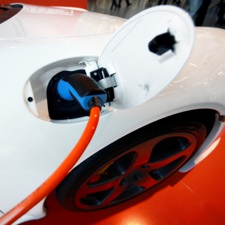 Plugging Highway Vehicles into the Electric GridFeb 19, 2009 - lauren Morello - Climatewire - Scientific American If enough plug-in electric vehicles communicate with the grid, they could provide cheap storage for excess electricity
SAN DIEGO -- The white Toyota Scion xB parked in a corner of the vast convention center here doesn't look too unusual, until you notice the fat cable plugged into its bright orange front grille. But its owners say it might be the smallest unit of California's electrical grid. The car, a plug-in hybrid electric vehicle, has been retrofitted by AC Propulsion to respond to signals from the California Independent System Operator -- giving it the ability to send power from its battery back to the grid. It's on display here at the annual meeting of the American Association for the Advancement of Science as proponents of so-called "vehicle to grid," or V2G, technology make their case. Backers say V2G could help balance the country's supply and demand for power, especially as renewable energy from intermittent sources like wind and solar becomes a larger part of America's energy mix. With enough cars participating, a V2G system could help buffer ups and downs in power production by allowing utilities cheap storage for their excess power. "One car doesn't make much difference," said Willett Kempton, director of the Center for Carbon-free Power Integration at the University of Delaware. "But when you have 100 cars or 1,000 cars, you actually start to talk about displacing power plants." Kempton, who will give a talk today at the AAAS meeting, originated the V2G concept in 1997. He's also spearheading a project that's put three V2G cars on the University of Delaware campus, where they provide power to PJM Interconnection, which operates the electric grid for much of the Mid-Atlantic and Great Lakes regions. The demonstration project -- known as the Mid-Atlantic Grid Interactive Car Consortium, or MAGICC -- is now "making money in the grid, actually collecting cash" for sending power back to PJM, said Kenneth Huber, the grid operator's senior technology and education principal. "Whenever these cars are plugged in at the University of Delaware, they're making cash." Well-connected cars make money Here's how it works. The cars on the University of Delaware campus are connected to PJM by an Internet connection. Every four seconds, PJM makes contact with the vehicles, allowing them to signal the cars to send power back into the grid in times of need. "PJM is required to have 1 percent of its peak power on any particular day to be provided in frequency regulation at 60 megahertz," said PJM's Huber. "At the same time, people are turning on load and off load, so we have to move our generation up and down to match the load." He compared it to a pond where water comes in and out, but the overall water level must remain constant. The advantage of using V2G to help smooth out peaks and valleys in power supply, and demand is clear, Huber said. V2G-equipped cars like the retrofitted Toyota or those on the University of Delaware campus can respond almost immediately to signals from PJM or other grid operators -- a much faster response than can be achieved by rejiggering production at power plants. For consumers, the lure is the ability to generate money as their cars sit unused, experts said. "As a consumer, you might buy [a V2G-enabled car] to save on fuel," Huber said. "Instead of paying $3 a gallon for gas, you could buy electric at night for 60 cents per kilowatt hour. And while you're charging at that low rate, you can make some money by saying, 'Go ahead and use my battery a bit.'" 'Big issues 'down the road' The Toyota displayed at AAAS, when plugged in between 12-20 hours a day, can earn between $5-10 per day by sending power back to the grid, he said. "Vehicle-to-grid is a perfect bridge technology that integrates and connects the electric grid to the transportation system -- to large sectors that have never been connected before," said Jasna Tomic, fuels program manager for CALSTART, a California-based group that advocates for cleaner transportation. But there's a long road ahead, said Jeff Stein, a professor of mechanical engineering at the University of Michigan. "There are some fairly incredible ramifications to this marriage that is going on," he said. "One is that with PHEVs, you have very large batteries that are being asked to do a lot more than what you might be thinking in traditional hybrid electric vehicles. This puts them at tremendous stress to their reliability and durability." That, combined with the cost and size of the batteries, is "a big issue down the road in making these commercially viable," Stein said. He's now exploring what he calls "health conscious" approaches to monitoring, charging and discharging batteries to minimize any harm to vehicles plugged into a V2G system. Raymond Boeman, director of the transportation program and National Transportation Research User Facility at Oak Ridge National Laboratory, agreed. "We have a lot of excitement," he said, "and a lot of progress made. But there's still a lot to be done in terms of the performance of components -- whether it's the battery, the car's electronic system, or electric motors." |
Email this page to a friend
If you speak another language fluently and you liked this page, make
a contribution by translating
it! For additional translations check out FreeTranslation.com
(Voor vertaling van Engels tot Nederlands)
(For oversettelse fra Engelsk til Norsk)
(Для дополнительных
переводов проверяют
FreeTranslation.com )


